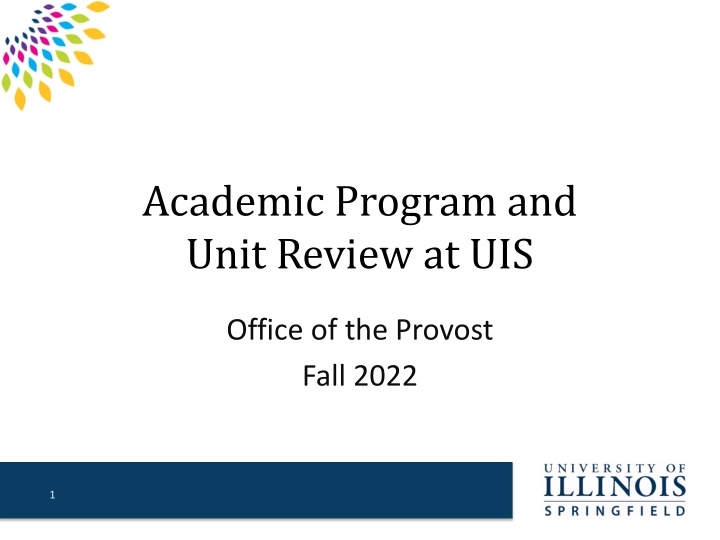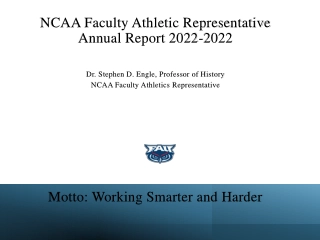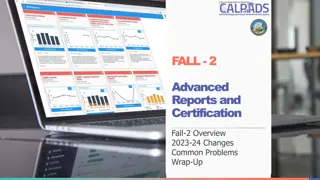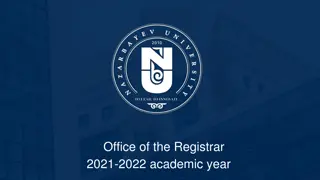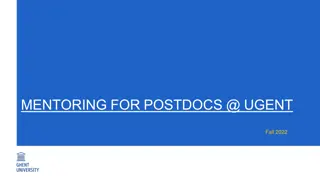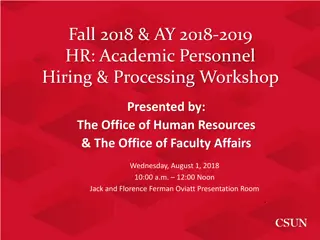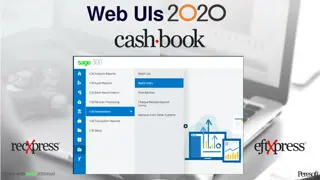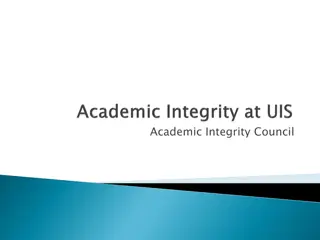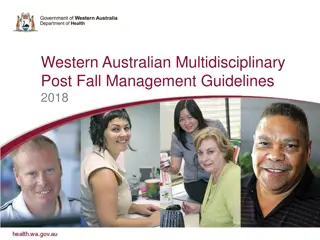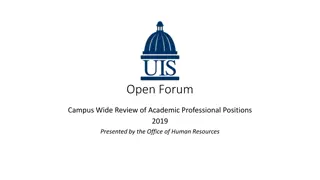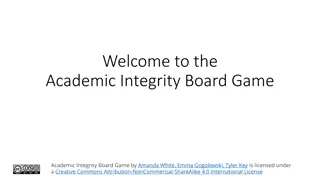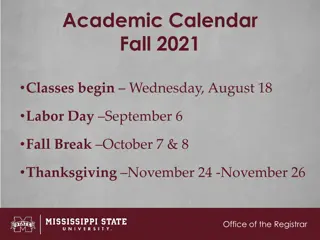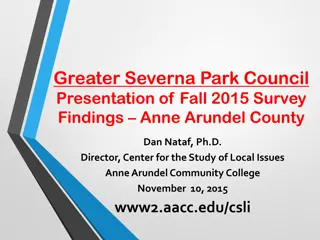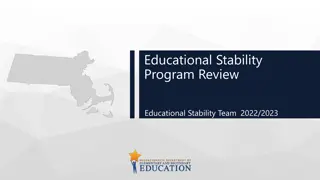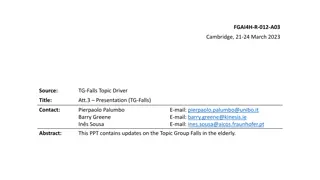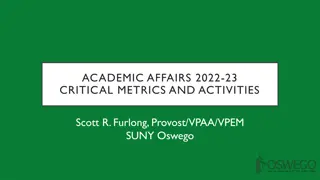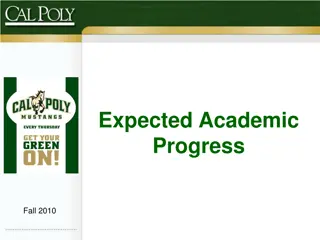Academic Program and Unit Review at UIS: Fall 2022 Overview
Explore the detailed process and importance of academic program reviews at UIS, focusing on evaluating program strengths, weaknesses, and opportunities for improvement. Key aspects include reviewing past recommendations, enrollment trends, curriculum updates, student outcomes, and program productivity. The timeline, guidelines, key questions, and data elements are outlined to facilitate a comprehensive review process.
Download Presentation

Please find below an Image/Link to download the presentation.
The content on the website is provided AS IS for your information and personal use only. It may not be sold, licensed, or shared on other websites without obtaining consent from the author.If you encounter any issues during the download, it is possible that the publisher has removed the file from their server.
You are allowed to download the files provided on this website for personal or commercial use, subject to the condition that they are used lawfully. All files are the property of their respective owners.
The content on the website is provided AS IS for your information and personal use only. It may not be sold, licensed, or shared on other websites without obtaining consent from the author.
E N D
Presentation Transcript
Academic Program and Unit Review at UIS Office of the Provost Fall 2022 1
Agenda Purpose of program reviews Timeline Data Elements & Resources Q & A Panel 2
Why Complete A Program Review? Opportunity for faculty to step back and evaluate direction of an academic program Evaluate strengths, weaknesses, and progress in order to create future plans and priorities What are we doing well? Where could we do better? How do we compare to our competitors? Required by IBHE & HLC. 3
Key Questions 1. Did we implement prior program review recommendations? 2. Is our enrollment growing/declining? 3. Is our curriculum keeping pace with changes in the discipline? How do we compare to our peers/competitors? 4
Key Questions (continued) 4. Are students meeting our program learning outcomes? Revise curriculum. 5. What data should we track annually to ensure that we are on track? Program enrollment Retention Internships/capstone enrollment 5
UIS Program Review Guidelines Program Objectives & Structure Assessment of Learning Outcomes & Curricular Revisions Student Characteristics Academic Support Faculty Learning Environment & Support Services Student Demand & Program Productivity Centrality to Campus Mission (e.g. the Strategic Compass) Costs Summary & Recommendations Comparison to peer programs 6
Timeline Route through Governance March-May (Curriculum Comm., Dean, VC) Form Committee & Review Data Sept/Oct Submit to IBHE September 2023 Write & Review Self-Study Nov-Feb. 7
Data Elements: Office of Institutional Research Located on the Institutional Research webpage within Restricted Access: http://www.uis.edu/institutionalresearch/ . Password protected: Password is programreview . Some data are currently available. Additional information will be loaded during the next four weeks. Contact Laura Dorman, Director of Institutional Research, for questions / further information at lgran1@uis.edu or 217.206.6005. 8
Data Elements: CASL Assessment Report Programs should include the CASL report, or a summary, as part of the academic program review documentation. Programs should describe how CASL recommendations were implemented. For more information see the CASL website: http://www.uis.edu/assessment/ 9
Resources in Box for Your Use Your Original IBHE Program Proposal. (three-year reviews only). Your Previous Self-Study, College Curriculum Committee Memo, Dean s Memo, Council Memo, IBHE Report, and MOU (if available). The PowerPoint and materials from this workshop. Program and Unit Review Guidelines, also available at: https://www.uis.edu/institutionaleffectiveness/academic-unit-program-review/ 10
Peer Panel Hei-Chi Chan Ken Owens Megan Styles 11
Questions? 12
Supplemental Resources Detailed Timelines IBHE Requirement Ideal 8 Year Cycle Special Cases: Minors, 3 year reviews, Externally accredited programs Takeaways 13
Phase 1: Begin Self-Study September 2022 February 2023 Step 1: Identify self-study committee. Meet to discuss key goals/focus and requirements of the self-study before October 15th. Step 2: Gather and analyze data. Consult with Laura Dorman, Kimberly Craig, and Dean s Office as needed. Data should be identified and gathered by November 15th. Self-study committee should meet to discuss data and to assign sections to write to team members. November-January. Step 3: Write report. Lead writer edits and compiles sections into the self-study. Drafting should be underway by February 7, 2023. Report should be completed by March 7, 2023. 14
Phase 2: Governance March 2022 April 2023 Step 1:Program or unit approves report by March 1, 2023. Step 2: Coordinator emails report in WORD format to the Program Review Coordinator by March 7, 2023at programreview@uis.edu . The email text must confirm the review has been approved by the program and contain that approval date. The Program Review Coordinator routes the report to the College Curriculum Committee for review. 15
Phase 2: Governance March 2022 April 2023 Step 3:CCC reviews report and prepares a recommendation memo addressed to the Dean no later than October 25, 2022. The Program Review Coordinator forwards report and CCC memo to Dean for review. Step 4:Dean or Administrator reviews report, prepares memo outlining recommendations and forwards all materials to the Program Review Coordinator by December 10, 2022. The Program Review Coordinator forwards report and memos to Council for review. Final Step: Provost s Office prepares MOU & IBHE Report. (Summer 2023). 16
Phase 2: Governance March 2022 April 2023 All program review governance document submissions and approvals are to be routed via email through the Program Review Coordinator in the Provost s Office at programreview@uis.edu . The Program Review Coordinator will distribute materials to each governing entity and collect approval documents for tracking purposes. 17
IBHE Requirements Public colleges universities are required to review all degree programs within a cycle of eight years and to submit a summary of each review to Academic Affairs staff. The reviews can lead to continuation of strong programs, corrective measures to address problem areas, and suspension or elimination of programs. http://legacy.ibhe.org/Academic%20Affairs/academicPrg/overview.htm For specific IBHE guidelines regarding program review see https://www.ibhe.org/assets/files/ProgramReviewGuidelines.pdf 18
Eight-Year Program Review Process IBHE report Department reviews results from the previous cycle. Committee on the Assurance of Student Learning (CASL) Review Program Review Self-Study Governance Reviews College Curriculum Committee Dean Undergrad/Graduate Council Campus Senate Provost IBHE Report CASL self-study Year 3 Governance review Year 8 Program review self-study Year 7 CASL review Year 4 19
Reviews of Minors & Certificates Program Description & Objectives Curriculum Students Faculty Student Demand Costs Quality & Productivity Recommendations 20
Three-Year Reviews (New Programs) Brief general description of the program, including learning outcomes, and any developments in the curriculum. Discussion of positive developments and challenges in implementation (student demand, changes for faculty, etc.). Plans for, or developments in, assessment of student learning. Analysis of performance measures including, if available: student enrollment in the program, enrollment in the courses associated with the program, pattern of course availability, number of credit hours generated by the program, and number of students completed (if any). 21
Externally Accredited Programs Criteria for Using Accreditation Documents for Program Review: Your program has through the accreditation /reaccreditation process within two years of the time the self-study is submitted (an IBHE requirement). The application for accreditation/reaccreditation was successful. 22
Externally Accredited Programs Next Steps: Review this crosswalk designed for programs that hold external accreditation: https://www.uis.edu/institutionaleffectiveness/academic-unit-program-review/ Contact programreview@uis.edu to learn more about this process. 23
Key Points Generate faculty interest by focusing on the Future Direction/opportunities. Start as soon as possible and create target dates. Address issues raised in the program s last review cycle. Use the process to reflect on your program s strengths and weaknesses. Does anything in the data surprise you? 24
Additional Key Take-Aways Demonstrate how your program has used assessment of student learning, and analysis of data, to make curricular revisions. Analyze data, including enrollments, and identify trends. Acknowledge any program challenges, and what your program has been doing, or plans to do, to address these. Integrate other planning or accreditation processes into your review when applicable. 25
